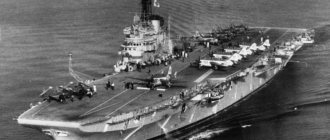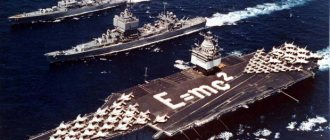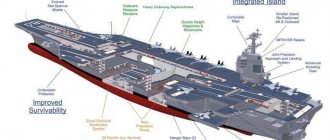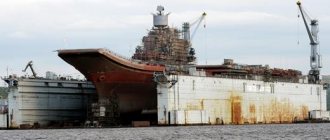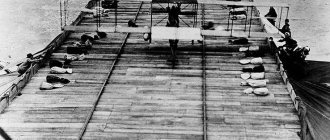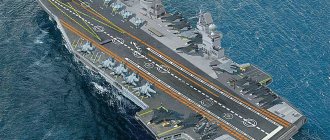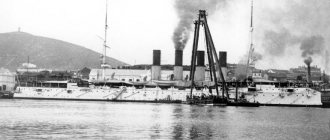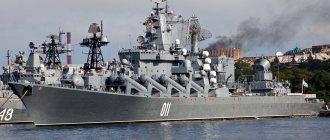After completing all checks, the aircraft-carrying cruiser changed its status from training to combat, reports Joinfo.com.
It is not specified whether any modifications to the aircraft carrier are planned after the test program.
Liaoning entered Chinese service in 2012. The Chinese authorities bought this Project 1143.6 ship “Krechet” from Ukraine in 1998 at the price of scrap metal. The PRC bought a rusting aircraft carrier from Ukraine for $23 million (official Ukrainian version; there is also information about the figure of $20 million). Later, the Chinese side claimed that they spent at least $120 million on the deal. By the way, the aircraft-carrying cruiser was sold to organize a floating entertainment center and casino, but was then resold to the Chinese government.
But most importantly, the Chinese received, in addition to the aircraft carrier itself, all the documentation and drawings of the aircraft-carrying cruiser.
Ukraine sold the Varyag aircraft carrier to China along with all documentation for only $20 million.
"How so?" - the reader will ask; the answer to this question can be found from those who were at the “feeding trough”. By the way, in not so distant 1998, under President Leonid Kuchma, Valery Pustovoitenko served as Prime Minister, and the Ministry of Defense was headed by Alexander Kuzmuk (remember, under him in 2001, the Ukrainian S-200 shot down the civilian airliner Tu-154M flight Tel- Aviv - Novosibirsk. 78 people died then, Ukraine admitted guilt and paid the families of the victims $15.3 million).
The aircraft carrier was developed at the Nevsky Design Bureau (Leningrad, USSR) and laid down in 1985 at the Black Sea Shipyard in Nikolaev, until 1990 it bore the name “Riga”, and then was renamed “Varyag”.
The aircraft-carrying cruiser was launched on November 25, 1988.
But in this state, Ukraine was selling its only rusting aircraft carrier, which it received after the division of the Black Sea Fleet.
Black Sea Shipyard: TAKR "Riga" - "Leonid Brezhnev"
The path of the Soviet aircraft carrier from the design drawing boards to the slipway, and from there to the water, was long and difficult. There was always no place for it in shipbuilding programs, and finished projects were continually returned for revision and processing. We must not forget about the opposition opposing the appearance of ships of this class in the USSR Navy. There were plenty of opponents of aircraft carriers both in the government leadership and in the military. When, it would seem, things got off the ground and construction began first of the helicopter carriers “Moscow” and “Leningrad”, and then of the heavy aircraft-carrying cruisers of the “Kyiv” type, the development of the Soviet aircraft carrier again took a sharp turn.
TAKR "Leonid Brezhnev" before descent
"Battle" for an aircraft carrier
Throughout the 70s. In the military environment, the struggle for the appearance of this class of ships in the Soviet fleet did not stop. The construction of aircraft carriers armed with horizontal take-off and landing aircraft was advocated by Defense Minister Grechko and Fleet Commander Admiral Gorshkov. Their opponents were the Chief of the General Staff, Marshal Ogarkov, and the Secretary of the Central Committee for Armaments (and future Minister of Defense of the USSR) Ustinov. By the mid-70s. The scales began to tip towards the group of supporters of the development of the aircraft carrier fleet, but the death of first Marshal Grechko, and then the Minister of Shipbuilding Boris Butoma, who also defended the construction of these ships, made its own adjustments.
It was decided to abandon the projects of ships 1160 and its reduced version 1153 code "Eagle" in favor of the gradual development of heavy aircraft-carrying cruisers 1143. In the fall of 1977, the Nevskoye PKB received an order to develop a technical proposal, and the research institutes of the Air Force and Navy received technical assignments for the development a ship equipped with aerofinishers and catapults. His air group, along with VTOL aircraft and helicopters, was supposed to consist of horizontal take-off and landing aircraft.
The promising heavy aircraft-carrying cruiser was supposed to provide stability to naval formations of the Soviet fleet in remote regions of the World Ocean, provide cover for deployment and patrol areas of nuclear missile submarines, and destroy surface and air targets. If necessary, strike at coastal targets.
The Nevskoye PKB, having worked hard, came up with five variants of technical proposals. One of them involved the construction of a ship with a nuclear power plant. For further work, the smallest displacement option was recommended, which had a boiler-turbine power plant and was equipped with one steam catapult. His air group was to consist of 18–28 Mig-29, Su-27 or Yak-141 aircraft and 14 helicopters.
TAKR - preliminary design 1143.5, 1979 Nevskoye Design Bureau
After the corresponding resolution of the Council of Ministers in October 1978, full-scale design of the new ship began. As has happened more than once, amendments and recommendations were constantly made to the final draft that was being formed, often contradicting each other. In the summer of 1979, Gorshkov demanded that the designers of the Nevsky Design Bureau strengthen the ship’s anti-aircraft weapons. At the end of autumn, a proposal to increase the air group was introduced into the project that had already been approved for final consideration.
The problem was that the main dimensions of the ship were limited by the length of the slipway of the Black Sea Shipyard and the Northern Dry Dock in Sevastopol, and Gorshkov’s proposal for an air group immediately increased the standard displacement of the project to 65 thousand tons, which was met with hostility by opponents. In the midst of aggravated contradictions, Marshal Ustinov signed a directive at the beginning of 1980, which proposed reducing the displacement by 10 thousand tons and abandoning the catapult. Airplanes had to take off from the deck from a springboard. The air group was supposed to consist of 40 aircraft and helicopters.
A certain danger for aircraft carriers lurked in the work on the Project 10200 Khalzan landing helicopter carrier, which began back in 1977 on the initiative of the Deputy Chief of the General Staff, Admiral Nikolai Nikolaevich Amelko, which was carried out by the Nikolaev Chernomorsudoproekt. It was based on a roll-on container ship 1609 code "Atlantika" with a gas turbine power plant, which was built by the Black Sea Shipyard in those years.
With a draft displacement of 30 thousand tons, this helicopter carrier was supposed to carry from 14 helicopters in the landing version to 28 in the anti-submarine version. In addition, the landing option provided for the placement on board of about 50 tanks and a battalion of marines. Such ships were considered by Admiral Amelko as a cheap alternative to specially built aircraft carriers. They were supposed to be built in Nikolaev, at the Black Sea plant, after the Project 1143 ships.
A struggle broke out around two actually competing vectors for the development of aircraft-carrying ships in the Soviet Navy, in which not only military departments were involved, but also the military-industrial complex. Ultimately, in 1980, Gorshkov and his supporters were able to keep the direction of heavy aircraft-carrying cruisers equipped with a ski-jump, and they decided to abandon the Khalzan project. However, the “aircraft carrier” battles at the top did not pass without leaving a mark on the entire development program.
As a result, the design period for a new heavy aircraft-carrying cruiser was delayed by two years, as was the start of its construction. While the top officials were once again deciding whether or not to be an aircraft carrier, and if so, what kind, the Black Sea Plant was working on the construction of the fourth ship of Project 1143.4 “Baku”. It was supposed to be launched in 1982, and in the vacant place they planned to lay down a new heavy aircraft-carrying cruiser with a ski-jump and aero arresting devices.
Design work
The preliminary design of the new ship was ready by the summer of 1980, but at that moment the conditions and requirements of the customer changed once again, and the project was not approved. Changes and recommendations poured in as if from a cornucopia - the composition and size of the air group was constantly changing. The anti-aircraft missile armament was adjusted upward: it was planned to install 8 firing modules of the Kortik anti-aircraft artillery complex. It was planned to place four cable aerofinishers and an emergency barrier on the deck. The Basalt anti-ship strike complex also “moved” from place to place several times. Its presence remained an integral part of the project.
The requirements for the future aircraft carrier were strict. When the desired was finally put on paper, it turned out that it would not be possible to meet the allotted displacement limit, which was also “cut off” by Ustinov. In the fall of 1981, Ustinov gave the go-ahead to increase the displacement by 10 thousand tons, which made it possible to significantly improve the project. The air group was expanded to 50 aircraft. Instead of the Basalt, it was decided to arm the ship with the more advanced Granit complex, the launchers of which were located below deck.
The relevant departments promised to carefully study the issue of the possibility of taking off Mig-29 and Su-27 aircraft from a ski-jump. In 1982, a unique complex (later NITKA) was put into operation in Crimea, where the testing of takeoff and landing on the deck of an aircraft-carrying cruiser began. The Black Sea Shipyard took a direct part in the creation of this complex. Its construction began in 1977 near the village of Novofedorovka, Saki region in Crimea.
General view of the aviation ground test training complex - NITKA
The idea of creating such a facility arose in the mid-70s, when active design work was underway on aircraft carriers 1153 code "Eagle". An additional incentive for the emergence of the future NITKA (Ground Test Training Complex Aviation) complex was Admiral Gorshkov’s visit to the American Lakehurst complex in New Jersey during his visit to the United States. Now in Crimea a ground-based analogue of the future aircraft carrier was being created with all the accompanying paraphernalia: aerofinishers, a take-off ramp and a catapult. All take-off and landing units with a total weight of 12 thousand tons were manufactured at the Black Sea plant, and then transported by sea to Novofedorovka, where final installation and assembly took place. All construction work at the site was led by the senior builder of the Black Sea plant, Alexey Ivanovich Seredin.
Springboard T-2 (THREAD)
Considering the springboard as a successful and, not least, cheaper replacement for the catapult, the General Staff ordered to stop all work on its design, which had been going on since 1972. This decision was controversial, because, despite all the apparent advantages of the springboard, ejection takeoff has its advantages.
It was planned to equip the future ship with onboard underwater structural protection against torpedo explosions - a lot of design and research work was carried out. For practical tests, two compartments weighing 450 tons were manufactured at the Black Sea plant, which were then welded to the side of the already decommissioned Kazbek tanker (also built by ChSZ) and tested with explosions. By March 1982, work on the project was generally completed, and on May 7 of the same year it was officially approved by a resolution of the Council of Ministers of the USSR. It received the digital designation 1143.5.
Construction
On September 1, 1982, order No. 105, the fifth heavy aircraft-carrying cruiser of Project 1143.5, was laid down at the “zero” slipway of the Black Sea Plant. The Commander-in-Chief of the USSR Navy, Admiral of the Fleet of the Soviet Union Sergei Gorshkov, arrived in Nikolaev for the laying ceremony. Initially it was called "Riga". However, after the death of the General Secretary of the CPSU Central Committee Leonid Ilyich Brezhnev on November 10, 1982, on November 22, “Riga” was renamed “Leonid Brezhnev”.
The construction of the building was carried out using the already proven “block” method. In September, the bottom sections were installed on the slipway, and in December, the assembly of blocks began on the pre-slip site. On February 26, 1982, the first block was already installed on the slipway. In total, according to the plan, the ship's hull was to be assembled from 24 blocks, each weighing 1,400 tons. The construction schedule was tight: comprehensive drawings for each block were issued monthly, and in aggregate for all specializations.
TAKR "Leonid Brezhnev" on the slipway, view from the stern. Photo from the book by Balakin S.A., Zablotsky V.P. “Soviet aircraft carriers. Aircraft carriers of the cruiser Admiral Gorshkov"
Two 900-ton cranes, which were controlled from a single control panel of the leading crane, allowed this scheme to operate synchronously and accurately, which made it possible to install blocks weighing 1,400 tons on the slipway and begin welding the assembly seam almost immediately. From assembly and welding shop No. 11, where the welding of the sections making up the future block took place, metal structures were delivered to the pre-slip site of the zero slipway by special trailers. These Finnish-made machines were received by the plant from the Baltic Shipping Company as part of an equipment exchange. Each of these trailers (workers nicknamed them “centipedes”) was capable of transporting structures weighing up to 350 tons.
About 3.5 thousand enterprises throughout the Soviet Union took part in the creation of the heavy aircraft-carrying cruiser of Project 1143.5. The electronic computers of the Black Sea Shipyard and the Nevsky Design Bureau were connected to each other by a communication line via telephone cable, forming a single system that made it possible to process a huge volume of design documentation. This approach greatly facilitated the construction and installation work - cable installation had already begun on the slipway. The formation of the hull proceeded in two directions at once from the mounting block - forward and aft and at the same time upward.
Of the entire rather significant range of weapons provided for by the project, a block of launchers of the Granit complex was installed during the slipway period. In order not to get caught in a “photo shoot” of a potential enemy’s reconnaissance satellite, the launchers were assembled secretly and loaded onto the ship under construction at night.
In 1985, the Leonid Brezhnev was already being prepared for launching. This was the first time a ship of such mass was launched at the enterprise, for which the necessary preparatory work was carried out. To more evenly distribute the load, they decided to carry out the order on four tracks. This was the first time this had been done in domestic shipbuilding. Decades earlier, it was planned to launch the battleship “Soviet Ukraine” in a similar way, but this ship was never completed.
"Leonid Brezhnev" leaves the slipway
On December 4, 1985, “Leonid Brezhnev” was solemnly launched. The next day it was moored at the Northern embankment of the Big Dipper for completion. Ahead of the new Soviet heavy aircraft-carrying cruiser awaited numerous new equipment, a new name and an extensive range of tests.
To be continued…
Now the Chinese aircraft carrier Liaoning
As part of the Chinese fleet, the aircraft carrier was named “Liaoning” in honor of the Liaoning province, writes JoinInfo journalist Vlad Mayorov. After a long reconstruction and testing, the aircraft carrier was launched again in 2011.
The displacement of the Chinese aircraft carrier Liaoning is 59.5 thousand tons with a length of 304 and a width of 75 meters. The ship can reach speeds of up to 29 knots, and its range is about eight thousand miles. The Liaoning is armed with three Type 1130 30mm anti-aircraft guns, three FL-3000N anti-aircraft missile launchers and two anti-submarine weapons.
The ship's air group includes 24 carrier-based J-15 fighters. They were developed on the basis of the Su-33 fighter prototype purchased from Ukraine. In addition, the ship's air group includes two Z-9C search and rescue helicopters, four Z-18J early warning helicopters and six Z-18F anti-submarine helicopters.
At the end of October this year, it became known that the assembly of the hull of an aircraft carrier of the Type 001A project was completed in China. This is the first ship of its class designed and built in China. Currently, all necessary equipment is being installed on the ship. Later it would house his air group.
New in blogs
– What impression did the news about the commissioning of the Liaoning aircraft carrier make on you?
– The ceremony of handing over the ship to the fleet and the first raising of the naval flag was attended by the General Secretary of the CPC Central Committee, Chairman of the People's Republic of China Hu Jintao, Premier of the State Council of the People's Republic of China Wen Jiabao and other party and government figures of the country. This once again emphasizes the importance of the ongoing aircraft carrier creation program and shows the importance the military-political leadership of the PRC attaches to this ship. In the United States, aircraft carriers are also transferred to the fleet in the presence of the president. But during the transfer of our aircraft-carrying ships to the USSR Navy, leaders of this level were never present.
– Is the Chinese Liaoning a full-fledged aircraft carrier?
– Currently, this is a training ship, the presence of which will help train carrier-based aviation pilots and aircraft maintenance specialists, as well as teach designers and shipbuilders of the national industry a lot.
But this is not just a training ship, but an unprecedented full-scale training ground, which could only be built by such a rich and forward-looking country as China. It will be used to set and practice the tasks necessary to create the next aircraft carriers. We will see how quickly and efficiently the Celestial Empire will begin to build up its aircraft carrier fleet. And our “Varyag” will help her in this, which neither Ukraine nor Russia needed and which China purchased with such benefit for 20 million dollars.
In addition, the PRC has built a ground-based test site for testing naval aviation and training pilots of the NITKA type (ground-based aviation test and training complex) in Crimea. In fact, the name according to the documentation was NIUTK - a ground-based test and training complex, which soon began to be called simply THREAD for convenience, since all its components - catapults and landing blocks were extended into a “thread” towards the sea. NIUTK was never called in common parlance.
The creation of its own aircraft carrier cost China much less than the cost of building such ships in the United States. The cost of the last American aircraft carrier George W. Bush reached 6.2 billion dollars, and the new generation American aircraft carrier Gerald R. Ford, whose delivery to the US Navy is scheduled for 2015, is already estimated at 8.1 billion, not counting 2. 4 billion for research and development (R&D) during design. At the same time, the cost of the Varyag, if completed, would be about $3.5 billion at current prices.
Time has shown that despite all the difficulties with which “Varyag” was purchased and then delivered, the game was worth the candle. The Chinese are good businessmen. When we now hear surprised exclamations: why are the Chinese suddenly commissioning our aircraft carrier, I can say the following: “Yes, because they turned out to be much smarter.”
– How was this aircraft carrier commissioned?
– In August 2011, the ship went out for a week of testing. The Chinese military said that the purpose of the exit was to check the main power plant (GPU). Then, in December 2011 and 2012, several more trips to sea were carried out. Initially, it was planned to put the ship into service at the end of 2012, but life made adjustments. The aircraft carrier was put into service on September 25, 2012 against the backdrop of an aggravation of the territorial dispute between Beijing and Tokyo over the Senkaku Islands (Chinese name - Diaoyu), which Japan and China consider their own. Perhaps the early transfer of the aircraft carrier to the navy is a political decision related to this conflict. In addition, the aircraft carrier was commissioned on the eve of China's main national holiday - the anniversary of the founding of the People's Republic of China, which is celebrated on October 1.
For the final commissioning of the Chinese aircraft carrier Liaoning, it will be necessary to conduct full tests, including the power plant at full speed, which is about 30 knots with a total power of four turbines of 200 thousand horsepower. An aircraft carrier must sail at full speed for at least three days, and this is a very difficult task. Our military representatives strictly monitored this. Whenever the ship stopped, everything had to start over.
In the USSR, factory sea trials and state tests of such ships, along with subsequent revision of mechanisms, final painting and control departure to sea, took one year. China will spend the same amount. I think the Chinese are soberly assessing the situation, since reports are coming from the Celestial Navy Department that it will take another three years to bring the aircraft carrier to full combat readiness. It is possible that Liaoning will eventually be commissioned as a full-fledged aircraft carrier. There are no technical obstacles to this.
China plans to create up to four carrier strike groups (ACGs) by 2022, each led by one strike aircraft carrier. An escort fleet for the AUG is already being built.
– What difficulties did China encounter when commissioning an aircraft carrier?
– It is very difficult to commission the power plant and the main steam system, the pipelines of which operate under enormous pressure of 64 kg/cm2 at a temperature of 470 degrees Celsius. It is known that the boilers were the weak link on our ships. This is the heart of the ship, just like the nuclear reactors on American aircraft carriers. KVG-4 boilers, producing 115 tons of high-parameter steam per hour,
- units that are unique in their characteristics, but at the same time very difficult to maintain, requiring constant supervision of the operation of the automation. The sailors had difficulty coping with this. After the factory crew left the ship, there were cases where the ship completely stopped moving. The Chinese knew this. While the Varyag was in Dalian, they removed one boiler and took it to the plant in Harbin, where they carefully studied and conducted extensive tests. It is likely that they brought the boilers to the required condition and improved the automation. However, tests and further operation of the aircraft carrier will show this. The Russians have still not been able to do this, as evidenced by the failure of tests of the Indian aircraft carrier Vikramaditya, which is being converted at the Severodvinsk Sevmash from our fourth TAVKR Admiral Gorshkov. According to reports from Russia, seven of the eight boilers on this ship failed while the aircraft carrier was at full speed.
The greatest difficulty for Chinese shipbuilders is the commissioning of the ship's aviation technical complex, which includes aerofinishers, an optical landing system, a radio-technical flight control system, an aviation fuel refueling system, a power supply system for aircraft and helicopters, aircraft lifts, gas ejector shields, and retention devices. aircraft before takeoff when the engines reach full speed. It is necessary to install equipment and systems to carry out routine maintenance of aircraft and much more. The most important on such a ship, where large quantities of flammable aviation fuel are stored, are fire protection systems. It is also necessary to ensure safe storage of ammunition and its rapid delivery to the flight deck from the depths of aircraft magazines. After solving these problems, China will come close to creating its own aircraft carrier fleet.
– What should the aircraft armament of this ship be like?
– “Varyag” was created to host the Su-27K (Su-33), MiG-29K fighters and the Yak-141 supersonic multi-role vertical/short take-off and landing fighter. When the ship was built in 1985–1991, the Su-27K and MiG-29K were superior in their tactical and technical elements to the US Navy's F-14D Tomcat and F/A-18C Hornet carrier-based fighters. And the Yak-141 generally outperformed the American F-35B short take-off and vertical landing aircraft by at least 20 years. The Yak-141 made its first landings on the Admiral Gorshkov aircraft carrier in 1991, and the United States still cannot accept a similar F-35B aircraft into service. In addition, the ship was to accommodate radar patrol and guidance aircraft Yak-44 RLDN and a whole family of helicopters - anti-submarine Ka-27, landing Ka-29, rescue Ka-27PS and radar patrol Ka-31 RLD. In total, 52 aircraft should be based on the ship.
– Why are only Su-33 fighters left on the Admiral Kuznetsov?
– The Su-27K, which received the designation Su-33 after entering service, and the MiG-29K are different aircraft in their capabilities. The first one stays in the air twice as long and takes more ammunition than the MiG-29K. But it is also 2.5 times more expensive. On the other hand, the MiG-29K aircraft is one and a half times smaller in size, which means that more of them can be placed on the ship. In addition, the MiG-29K was more maneuverable in combat and had an excellent electronic weapons control system not only for air-to-air missiles, but also for air-to-surface missiles, that is, it could be used as an attack aircraft to destroy ships and ground targets. Both planes are good. Therefore, it was planned to deploy three types of fighters on the Varyag - the Su-27K and MiG-29K, which complemented each other, as well as the Yak-141 fighter. Construction of the MiG-29K and Yak-141 was stopped due to a stop in funding during the collapse of the Soviet Union. Now the MiG-29K fighter has been revived for the Indian aircraft carrier Vikramaditya. Of course, the Yak-141 will be in demand if the Russian aircraft carrier fleet is revived; in particular, it could be used in the near future on Mistral-class helicopter carriers.
– Will China be able to provide aircraft for its new aircraft carrier?
“A carrier-based fighter is now being created on the basis of the Su-27 aircraft, which will meet the most modern requirements. In the 90s of the 20th century, China bought a batch of Su-27 land fighters from Russia and a license to manufacture them. Production of Su-27 aircraft (Chinese designation J-11) is organized at an aircraft plant near Harbin. I saw the J-11B at the Harbin exhibition in 2006 and was very impressed. I never would have thought that China would be able to create and master the production of its own version of one of our best fighters in a short time. Now, based on this aircraft, China is creating the J-15 carrier-based fighter, which in its performance characteristics will resemble the Russian Su-27K fighter, and perhaps even surpass it. After all, more than 20 years have passed since the creation of the Su-27K, and the technology has not stood still. It should be noted that Ukraine also helped the Celestial Empire by selling it a prototype of the Soviet-era Su-27K aircraft, which was located in Crimea at the training ground with the NITKA complex. The J-15 aircraft will form the basis of the air wing of the Liaoning aircraft carrier and the two subsequent ships that are currently being built. The second and third aircraft carriers, similar to our Admiral Kuznetsov
and “Varyag”, it is planned to commission the Navy in 2015 and 2022. The Chinese Z-8 AEW long-range radar patrol helicopter will also be based on these ships.
To make a full-fledged aircraft carrier, a radar patrol and guidance aircraft like our Yak-44 RLDN or the American E-2C/D Hawkeye must be designed and built to control naval aviation and guide it to targets. This is the most difficult task for a ship that does not have a catapult, because this aircraft is quite heavy. We didn’t solve it at the time.
– What are the differences between the fifth Nikolaev aircraft carrier, Admiral Kuznetsov, which is now part of the Russian Northern Fleet, and the sixth, Varyag?
– The aircraft carriers “Admiral Kuznetsov” and “Varyag” were built according to the same project – 11435, but on the latter they decided to replace the Mars-Passat and “Fregat-MA” early warning radars with the new “Forum” radar complex. At the same time, it was decided to install a new TK-146 electronic warfare complex, the Sozvezdie-BR, to replace the similar Cantata-11435 complex installed on the Admiral Kuznetsov. The replacement of these two large avionics systems resulted in a reconfiguration of the ship's superstructure and a complete redesign of over 140 rooms. ChSZ managed to complete this work by the end of 1991. Therefore, “Admiral Kuznetsov” and “Varyag” have some architectural differences.
– When was the construction of Varyag stopped?
– Construction of the Varyag was stopped at the beginning of 1992 when the readiness of the aviation complex was 67.7 percent, and the readiness of the aviation complex was about 80. Aviation lifts and aircraft ammunition elevators were already operating on temporary power supplies, aerofinishers, an aviation fuel system, and a system for transporting aircraft and helicopters were installed in the hangar. The installation of the machine and boiler rooms on the ship was completed, and the condition of the power compartments made it possible to receive power, begin turning the mechanisms and carry out mooring tests. The ship was planned to be delivered to the Navy in 1993. However, at the beginning of 1992, funding for construction from the Russian Navy stopped. The ship was towed to a new berth, which was specially built for the seventh aircraft carrier, the nuclear-powered Ulyanovsk, guards were placed, and it remained there for many years awaiting its fate. Many buyers came, but the most persistent was China, to which the Varyag was sold. Selling such a ship is a very difficult process, since it is a military product and at that time the ship contained a lot of secret information. It was necessary to convince the Ukrainian government, as well as Russia, that all sensitive equipment would be removed from the ship before sale.
– What is the history of the sale of “Varyag”?
– This is a separate big topic, almost a detective story. Ivan Iosifovich Vinnik knows her best, in the past the chief builder of aircraft carriers, and when the Varyag was sold, he was the deputy general director of ChSZ. He received Chinese delegations, and then repeatedly flew on the Varyag to Dalian. The cost of the aircraft carrier as scrap metal at world prices was about five million dollars. China paid, as I already said, 20 million and won the tender. However, even at that time it was clear that the ship was not being purchased as scrap metal or a casino, but as a future aircraft carrier.
– What participation did the Black Sea Plant take in the restoration of the ship?
– “Varyag” arrived in Dalian on March 3, 2002 with three representatives of ChSZ on board, who accompanied the ship during the entire towing period. For three years no work was performed on the ship. A thorough study of its design and preparation for production was underway. In April-May 2005, the ship underwent dry docking, confirming the excellent condition of the hull steel. This was facilitated by the high-quality paintwork of the underwater part and the measures taken at the Black Sea Plant to prevent electrochemical corrosion of the hull. During docking, the outer side was cleaned and painted according to the full scheme used in the Chinese Navy. All bottoms and adjacent sides of the tank are cleaned and primed. The superstructure and upper deck have been painted. The paintwork on the drinking water tanks, made at ChSZ, turned out to be of such high quality that no additional work was required to restore it. Although 15 years had passed since work on the ship was completed in 1991, much of the interior looked as if it had just been primed and no new paint was needed. Dock repairs were done thoroughly and quickly. The work was carried out around the clock, all brigades had radio control, and the organization of their actions in the vast sub-bottom spaces was impeccable.
An inclining test carried out in October 2005 showed that the most important characteristic for the ship, stability, was normal. The Chinese have demonstrated that they can cope with the most complex warship, which is an aircraft carrier. A small group of six representatives of the Black Sea plant took part in the docking. Then access for Ukrainian specialists to the Varyag was closed and after 2005 they did not appear there. The Celestial Empire carried out all the work independently. The ship is a military facility, and the PRC keeps its secrets just as we did in the Soviet Union.
– Do you regret that you couldn’t finish the construction of this ship?
- Of course, we regret that we did not complete the Varyag. But in general, it’s good that the aircraft carrier was not cut up, as happened with the Ulyanovsk. There are three of our aircraft-carrying ships in China - “Kyiv”, “Minsk” and “Varyag”, and I am pleased that they are not cut up for scrap metal, but demonstrate the achievements of our shipbuilding in the years of its greatest prosperity.
– What features do the aircraft carriers “Admiral Kuznetsov” and “Varyag” have in comparison with the American ones?
– US aircraft carriers are ships of a higher class and have a more powerful aviation group, numbering up to 80 aircraft. In addition, they have a nuclear power plant, which provides them with an almost unlimited navigation area. The Kuznetsov and Varyag were equipped with the Granit anti-ship cruise missile system, capable of hitting targets at a distance of over 500 kilometers at a speed of M=2.5, that is, more than 3,000 kilometers per hour. In the 90s, it was a formidable weapon and the Americans were afraid of it. But in general, the deployment of missile weapons on our aircraft-carrying ships reduced their capabilities as aircraft carriers. Our aircraft carriers did not have catapults for taking off aircraft, and this also limited their capabilities. The catapults were to be installed on the seventh aircraft carrier, the nuclear-powered Ulyanovsk.
– What difficulties did ChSZ encounter during the construction of Ulyanovsk?
“We went our own way in creating aircraft carriers, and our heavy aircraft-carrying cruisers, super-saturated with weapons, certainly posed a threat to a potential enemy and were the subject of serious analysis by military specialists from NATO countries. We only had one step left to make these ships nuclear. They had plenty of everything else.
The total power of the four-shaft nuclear power plant at Ulyanovsk reached 280 thousand horsepower (4x70 thousand) - more than on the American nuclear-powered aircraft carriers of the Nimitz type, whose nuclear power plant capacity is 260 thousand horsepower. In 1990–1991, ChSZ received reactor vessels, steam generators, pipe systems, pumps, filters from Russian enterprises and began installing a nuclear steam generating plant. We managed to weld one block, the second was assembled and prepared for welding. The ease with which work on the Ulyanovsk ship progressed at the Black Sea plant suggests that we were ready to create this type of ship much earlier. At the time of termination of construction, the almost completed Ulyanovsk hull with the main mechanisms stood on the zero slipway. With the creation of this ship, we reached the level achieved by American shipbuilders.
The Varyag was supposed to be handed over to the fleet in 1993, and the next one, the nuclear-powered aircraft carrier Ulyanovsk, in 1996. The Black Sea plant was preparing to cut metal for the second nuclear-powered aircraft carrier of Project 11437 (order 108, not yet named), which was to be laid down immediately after the launch of the Ulyanovsk in 1992. Thus, if the outlined plans for the construction of aircraft carriers with the frequency of delivering one ship to the fleet every three years had been implemented, then by 2010 the Varyag aircraft carrier and five Ulyanovsk-class nuclear aircraft carriers could have been built and transferred to the Navy. And three more would be under construction.
The social and economic cataclysms that occurred during the perestroika period destroyed these plans. If we ever have to start over, we will need to spend a lot of effort, money and time to achieve the technical and intellectual milestone we were already at. Experts from leading countries in the world classify the design and construction of nuclear aircraft carriers as unique technologies, and by the end of the 80s of the 20th century we already owned such technologies.
– What kind of aircraft carriers do you think Russia will build in the future?
– Russia is going to resume the construction of aircraft carriers in 2020. They will start catching up again, but now it will be China. The Russian press reports that the new aircraft carrier will be similar in size to the current Admiral Kuznetsov, but, of course, built at a higher level. The design of ships of this class was carried out by one of our largest design bureaus, the Nevskoe Design Bureau in Leningrad, which worked in continuous and strong connection with ChSZ in Nikolaev for 70 years. Throughout the 20 years since the cessation of construction of aircraft-carrying ships, the NPKB continued to design and improve them. I think that the new Russian aircraft carrier will be built at the technical level of the best ships of the 21st century.
– What can you say about the future fate of Ukrainian shipbuilding?
– The state of the industry directly depends on cooperation with Russia. Southern shipyards have always played a large role in the creation of the Navy of Tsarist Russia, and then the Soviet Union. During Soviet times, Ukraine produced about 40 percent of the ships for the Navy, not counting, of course, nuclear submarines, the production of which was concentrated in Russia.
In my opinion, Russia now lacks the production capacity to revive its Navy, while Ukraine has seven large shipyards. ChSZ in Nikolaev is a builder of battleships, cruisers, submarines and aircraft carriers - the largest of them.
Nikolaev shipbuilding plants have enormous technical potential, and personnel for them are trained here, in one of our best educational institutions - the National University of Shipbuilding named after Admiral Makarov, which from 1930 to 1994 was known as the legendary Nikolaev Shipbuilding Institute. Nikolaev shipyards were historically and technologically formed to create ships full of complex military equipment. It is in this direction that they will be able to best prove themselves in the future. I think that the future of our shipbuilding lies in close cooperation with Russia.
The symbol and pride of China is the Liaoning aircraft carrier.
The converted Soviet aircraft carrier Riga, renamed Varyag, developed in Leningrad and built at the Nikolaev shipyards, rusted in Ukraine and was actually stolen, sold for pennies in 1998, became the new symbol and pride of China.
In China, they even wrote the song “Leading the Dream” and made a video clip dedicated to the Liaoning aircraft carrier. The patriotic video captures the everyday life of the aircraft carrier crew, the J-15 carrier-based fighter taking off and landing on the cruiser.
Let us remind you that a video of fighter jets training on the deck of the Admiral Kuznetsov also appeared online.
Alien life of a Soviet aircraft carrier
In 1990, when “Riga” was already at the outfitting wall, and “Tbilisi” was undergoing testing, these names already looked “politically untimely” - both in Georgia and in the Baltic states they were loudly talking about independence from Moscow. As a result, 1990 became the year of massive renaming of aircraft carriers. "Tbilisi" became "Admiral Kuznetsov", and "Riga" became "Varyag". The third ship to change its name was the Baku, which was already in service with the Northern Fleet - it was renamed Admiral Gorshkov. No one could yet guess about the further fate of these ships.
Naval timelessness
The collapse of the USSR led to the rapid degradation of the fleet, and the aircraft carrier program suffered the fastest and most severely. Already in 1992, the completion of the nuclear aircraft carrier Ulyanovsk was canceled, and work on the almost finished Varyag was suspended. The following year, 1993, three of the five aircraft-carrying cruisers in service - Kyiv, Minsk and Novorossiysk - were sent for mothballing. In 1994, “Admiral Gorshkov” also stood up to the wall.
Around the same time, it became finally clear that Russia would not complete the construction of the Varyag, despite heated discussions on this matter: supporters of the completion of the aircraft carrier even organized a visit to the ship by Russian Prime Minister Viktor Chernomyrdin. It is possible that Boris Yeltsin’s decision to complete the nuclear-powered missile cruiser Yuri Andropov (now known as Peter the Great) put an end to the fate of the Varyag. There was no longer money in the budget for a second large ship, especially one being built by a Ukrainian company.
The fate of the decommissioned aircraft carriers turned out to be similar. Quite quickly, three of the four Soviet aircraft-carrying cruisers of the first generation (intended for vertical take-off and landing aircraft) - Kyiv, Minsk and Novorossiysk - were sold abroad. “Kyiv” went to China, “Minsk” and “Novorossiysk” went to South Korea. The first Soviet aircraft-carrying cruiser was luckier than others - today the Kyiv TAVKR, which retained its name on board, became part of the naval museum in Tianjin. The Minsk, which they wanted to turn into a floating entertainment center, did not do business, and the Novorossiysk was cut into pieces.
In 1998, a foreign buyer was found for Varyag. The Chinese agent was Chong Lot Travel Agency Ltd, which officially intended to rebuild the aircraft carrier into a floating entertainment center.
In 2000-2002, the ship was towed for a long time and with various adventures to China, where it arrived at a shipyard in Dalian. Quite quickly it became clear that the Varyag could become anything, but there would be no entertainment center on board.
Opposing brothers
Since 2005, most naval experts no longer doubted that China intended to use the former Soviet aircraft carrier for military purposes. Jane`s Fighting Ship named the ship's supposed new name - "Shi Lang" and tail number "83". Official Chinese confirmation that the ex-Varyag would be used as an aircraft carrier came in 2011. This year, the ship went to sea under its own power for the first time in its history.
The new aircraft carrier entered the PLA Navy (People's Liberation Army of China) on September 25, 2012 under the name “Liaoning”, receiving tail number “16”. Soon, testing of Chinese J-15 fighters, created in the image and likeness of the Soviet Su-33 aircraft, a carrier-based version of the Su-27, began from the deck of the aircraft carrier.
The Liaoning celebrates its 25th anniversary as one of the most promising ships in the Chinese fleet, opening the way to the further development of carrier-based aviation in this country. And ironically, one of his main opponents in the coming decades may be his “elder brother” - on November 16, 2013, the aircraft carrier Vikramaditya, the former Admiral Gorshkov, and the former heavy aircraft-carrying cruiser of the USSR Navy Baku, was transferred to the Indian Navy.
The contrast between Liaoning and Vikramaditya has become one of the most popular points of contention in naval forums. The Liaoning, which is larger and carries heavier fighters, in the opinion of many, should have an advantage, but doubts about the capabilities of the Chinese copy of the Su-33 and the excellent, judging by the available information, characteristics of the MiG-29K and its weapons at least neutralize this superiority. In addition, the smaller size of the MiG-29K in this case makes it possible to equalize the number of air groups, despite the large area of the Liaoning hangar deck. India’s continuous experience in operating aircraft carriers since 1961 cannot be discounted, while for China this is the first such ship.
The fate of Liaoning and Vikramaditya is especially interesting in the context of processes occurring in other countries in the Indo-Pacific region. The naval programs of leaders (USA, China, India, Japan) and smaller countries indicate that the level of naval competition in the region will increase sharply in the next 20-25 years.
Russia also has its own plans, which in the next 10 years will have to almost completely renew the Pacific Fleet. One can only guess what role the two former Soviet aircraft carriers, who by the will of fate ended up in the fleets of two rival powers, will play in the history of the region. However, it won’t be boring in any case.
The author's opinion may not coincide with the position of the editors
